How To Automate Email Marketing Strategy On Shopify
Unless you’ve been living under a rock, it’s been clear for a while now that email marketing automation is playing a key role in helping grow your business. We’ll show you how to automate email marketing efforts on Shopify so you can take full advantage of the platform while knowing how and when to scale.
Automation is providing many new ways for every business to increase efficiency and productivity and reduce costs. It also allows for more efficient order processing and management, faster order fulfillment, improved customer relationships, and more accurate inventory tracking.
In this blog, post we’ll unpack one specific area of automation your business should focus on – email marketing automation.
Ready to save time by automating email? Install MESA to easily manage marketing campaigns for your business.
Topics:
Included email marketing automation on Shopify
Email marketing automation is a great way to build customer relationships, share helpful content, and expand your customer base.
With features like segmentation and targeted emails, you can send personalized emails with the right message, specifically to the customers who are most interested in your products.
Shopify offers many email messages by default, which allows you to immediately take advantage of automation without needing to go through intensive design or development processes or find the right email service provider.
Here are what email marketing tools you’ll get right off the bat:
Abandoned cart emails
Reach out to customers who have added items to their cart but haven’t completed the purchase.
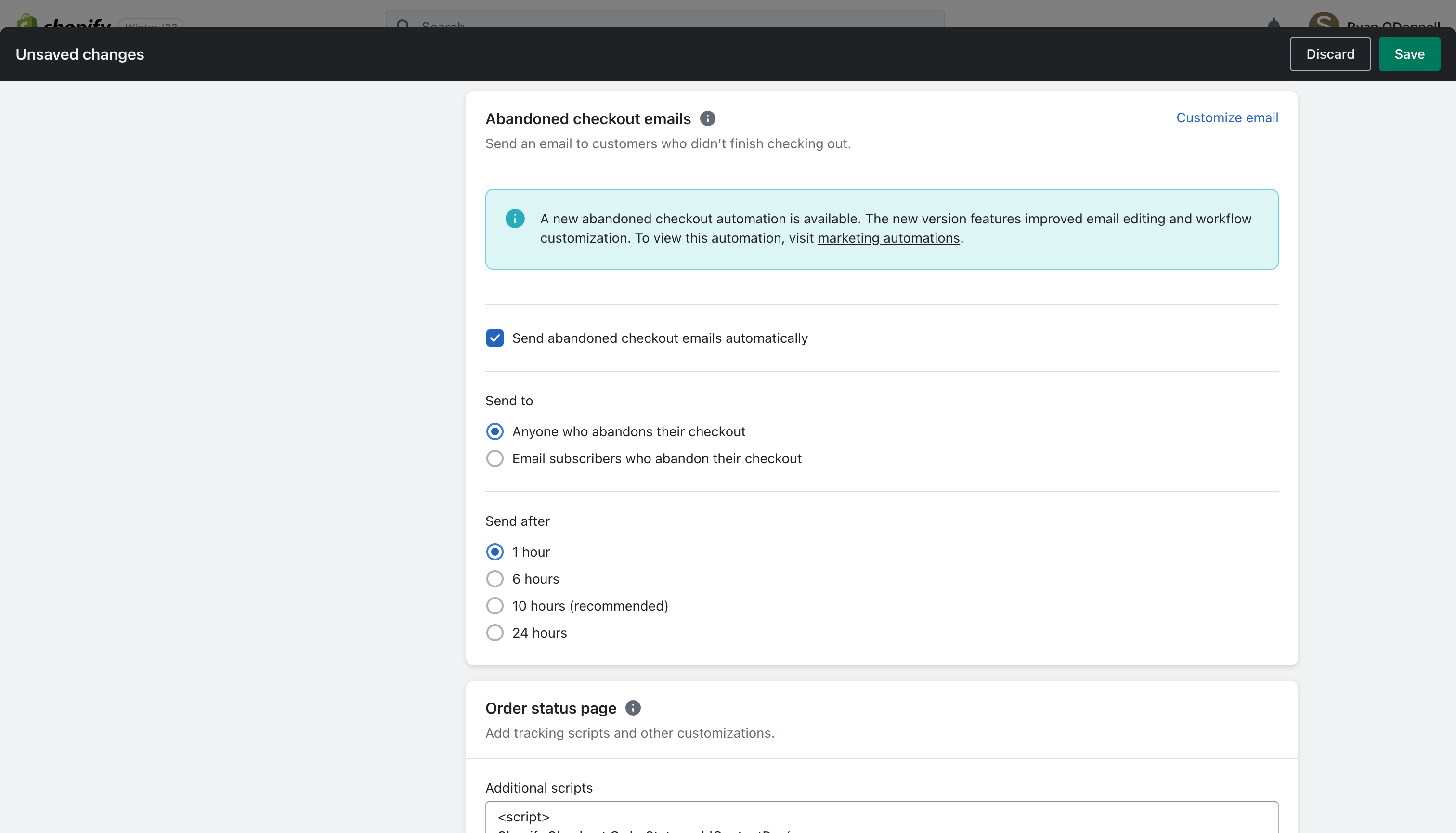
To set this up, head to Settings > Checkout. Scroll to the “Abandoned checkout emails” section. Then, look for the option ‘Send abandoned checkout emails automatically’.
After enabling this option, you can then head over to the Settings > Notifications section to customize the related automated email.
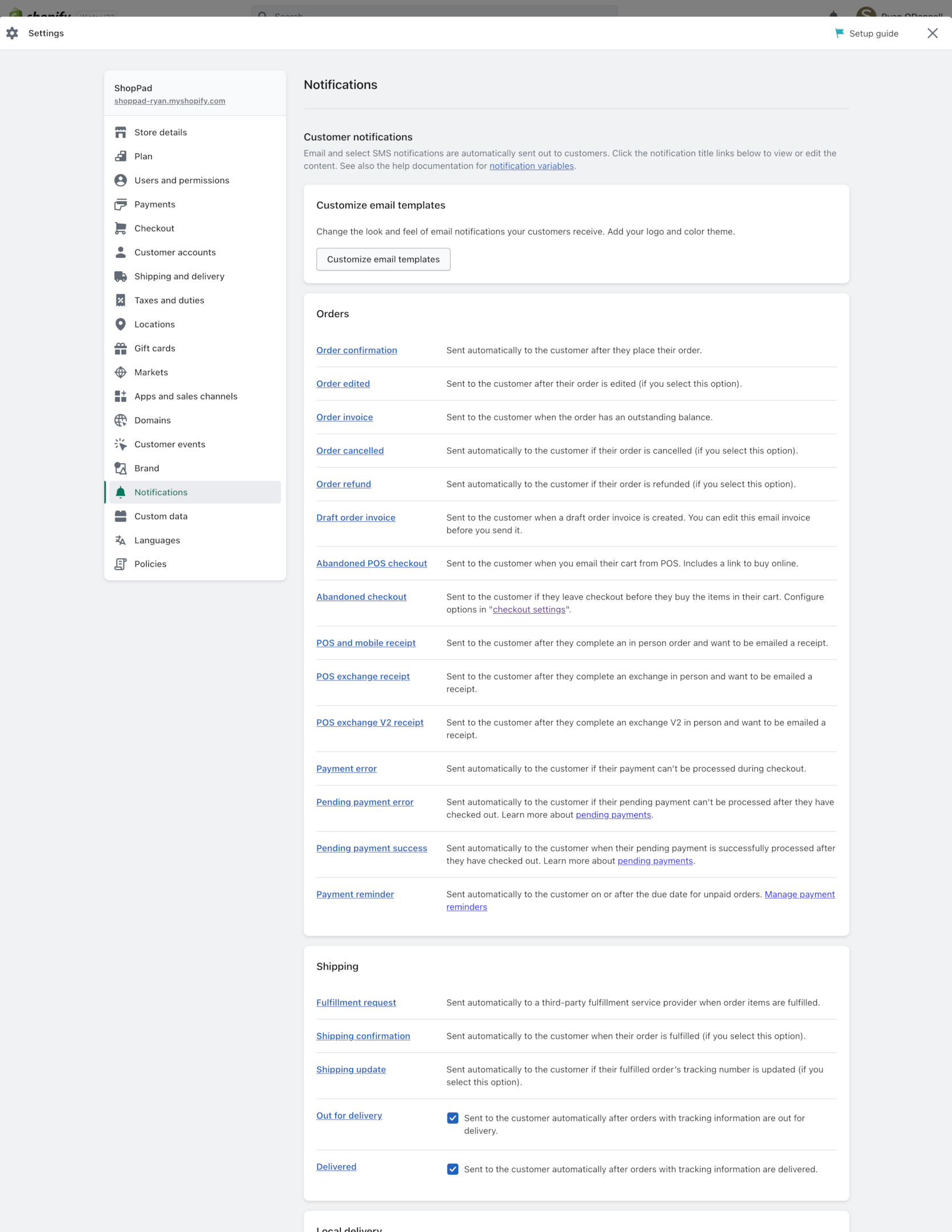
From here, you can customize every automated email in Shopify.
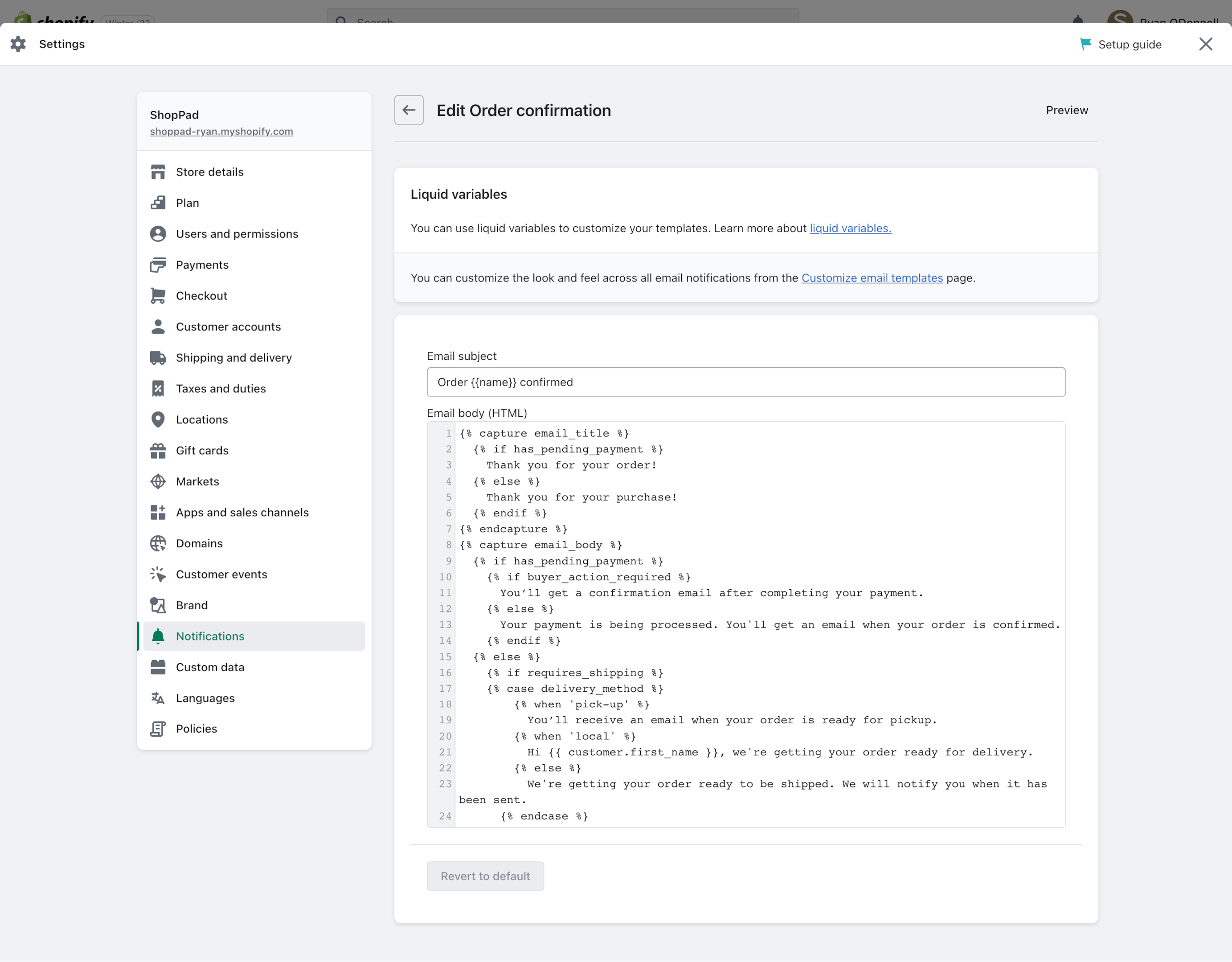
Click into the email messages then, edit the code of each email automation to customize the content.
Order confirmations
Shopify automatically sends order-related email confirmations to customers as soon as they complete their order, when refunds or cancellations take place, when any in-store POS events occur, and when any payment event occurs like reminders or errors.
Shipping & Fulfillment
Handling repetitive tasks like backoffice notifications can be tedious. Shopify includes automated email when orders are fulfilled, out for delivery, and delivered. If your Shopify store supports local fulfillments, all of those local delivery delivery notifications can be enabled too.
Customer communications
Any time a customer account is created or a customer requests their password to be reset, are naturally included too. These sorts of transactional emails would be a royal pain to setup if Shopify didn’t handle this for you.
Setting up new email marketing automation on Shopify
Setting up a new automated email on Shopify is easy, and when done right can have a huge impact on your ROI. By using the right triggers, segmenting existing customers, and emphasizing personalized messaging, you’ll be able to quickly get the most out of email marketing automation.
Here’s a list of the email automation types that aren’t supported by default:
Shipping Update Emails:
Shipping update emails are sent to customers as soon as their orders have been shipped, providing them with all the necessary details about the shipment and giving them an estimated arrival date. An automated email series that fires emails when the order status changes can help minimize support tickets by keeping customers more informed.
Review Request Emails:
Encourage new customers to leave reviews and gather feedback on your products or services by sending them review request emails. This is great when you’re trying to solicit reviews on other sites than your website.
Re-engagement Emails:
Send emails to customers who haven’t been active on your store in a while to re-engage them and bring them back as potential customers again.
Upsell/Cross-sell Emails:
Setup drip campaigns to customers offering them special deals on products or services related to the ones they have already purchased.
Shopify Email App
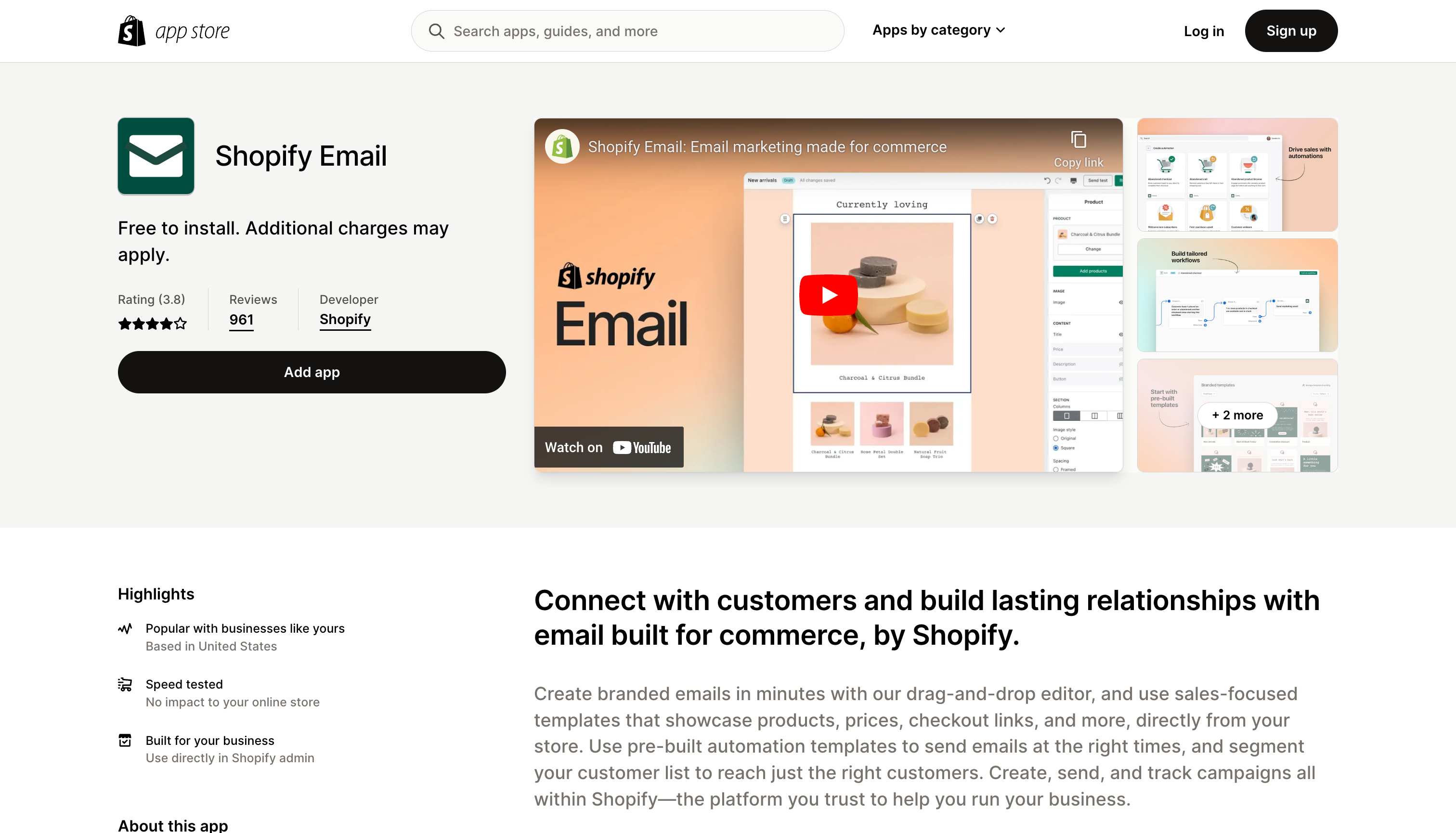
★★★☆☆ (3.8 Rating) – Shopify App Store
Pricing: Free to install – The first 10,000 manual or automated emails each month are free. Then, it’s $1 USD for every 1,000 emails you send.
Shopify offers their own app to send an automated email campaign. Their easy to use editor lets you create emails, add personalized content and other customer data via Liquid if you’re comfortable writing code. It’s a great, lightweight way to get started with email marketing and automating the customer journey.
Shopify Flow + Shopify Email for automated workflows
One popular option as a third-party app on Shopify to drive email marketing automation is Shopify Flow. It’s an incredibly automation tool to save time and increase customer engagement. With a few simple steps, you can easily set up marketing emails that will keep your customers engaged, informed, and ultimately help grow your business.
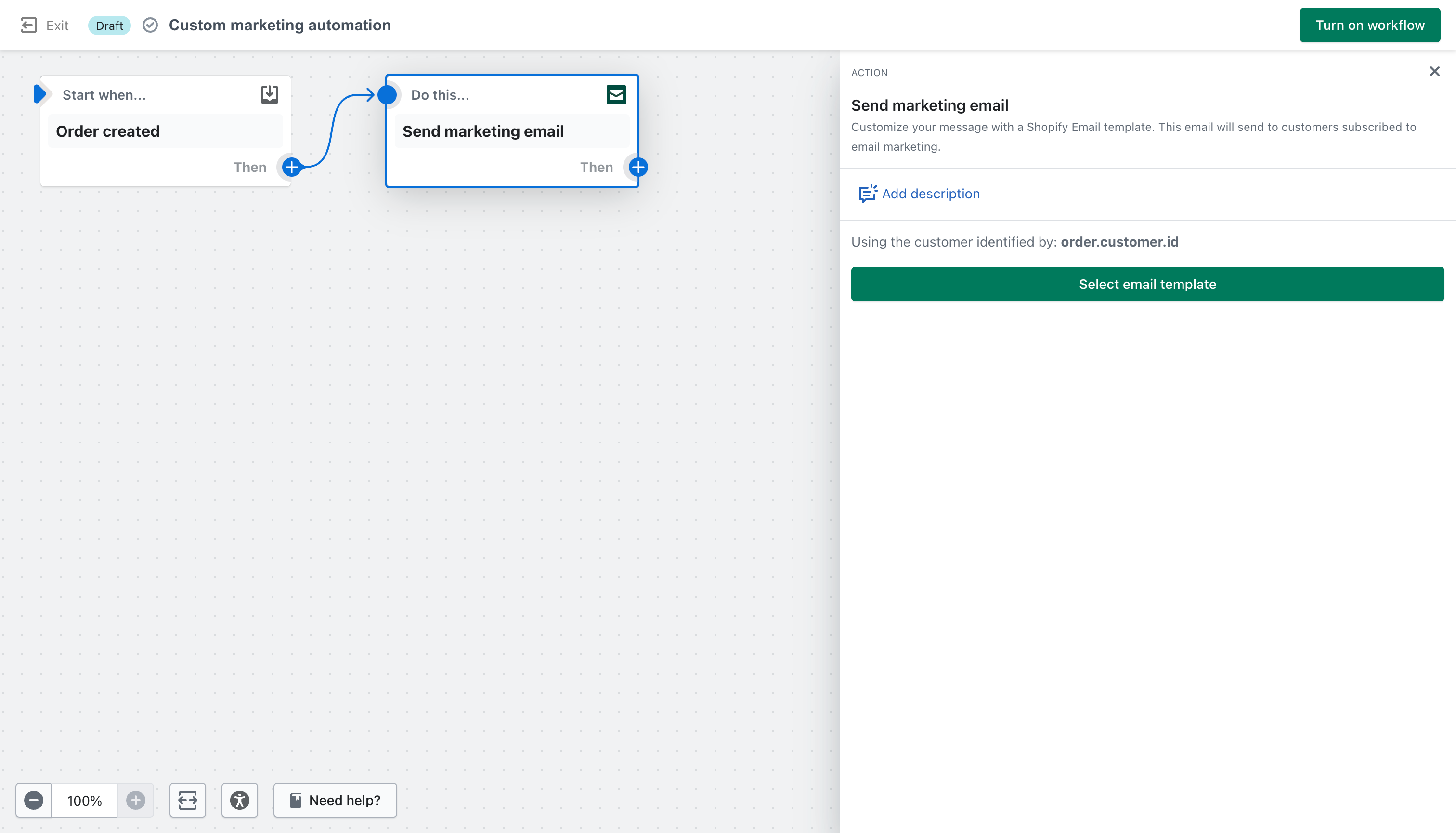
Creating effective marketing emails for your automated campaign
When creating email and marketing automation campaigns, it is important to craft the message with good language, the right tone and a personal touch.
Keep in mind that email automation is impersonal by nature, so you can’t rely on personal connections like you would in other types of communication. Instead, it is important to maintain an authoritative voice while providing concise information that appeals to your subscriber list.
Connect with individual subscribers by identifying their pain points and outlining how your offerings can help. And explain the benefits of moving forward with a call-to-action for them to take advantage of.
Tips on how to create impactful email content:
Research – Start by researching what kind of content resonates best with your target market and then craft personalized emails that directly address their needs.
Make it personal – Incorporate personalization in the subject line and content of the email to make it feel more relatable and engaging.
Be succinct – Keep the content of your emails clear and concise so that readers can quickly digest the information.
Include a call-to-action – Make sure to include an enticing call to action in each email to encourage recipients to take the desired action.
Track performance – Finally, keep track of the performance of each email campaign so you can make adjustments as needed to ensure maximum click through rates.
Best practices for email automation on Shopify
There are a few important best practices you should keep in mind to make sure you get the most out of email automation in order to grow your business.
Let’s take a look at a few do’s and don’ts of email marketing automation.
Do’s
Segment your audience: To ensure that you create content that resonates with each recipient, it’s important to segment your email subscribers and customize the emails according to their interests. For example, a new subscriber would benefit from welcome emails that underscore your brand values while an email subscriber that makes purchases from ads on social media platforms want different information.
Personalize your emails: Create tags for personalization (code snippets unique to email clients) such as first name or product preferences, you can make the content more relevant and engaging. This will help help improve the sales funnel as a result.
Test your emails: Make sure to thoroughly test your emails before sending them out, so you can be sure the content looks and reads correctly. Testing isn’t just about quality control but exploring more ideas to understand what content is performing best. For example, test subject lines against new subscribers to know which has the best open rate.
Provide value: Make sure that the content of your email marketing campaigns provides value for readers; this could mean providing helpful tips or offering exclusive discounts.
Don’ts
Spam your subscribers: Never send out emails that are irrelevant or too frequent, as this could cause people to unsubscribe.
Be too salesy: Aim for an appropriate balance between promotional and informational content in your emails.
Neglect mobile optimization: Make sure your emails are optimized for both desktop and mobile devices; a poor user experience can lead to a lower click through rate.
Forget to monitor your metrics: Regularly track the performance of your email campaigns so you can make changes where necessary.
By following these best practices and using effective automated email campaigns, you can create meaningful connections with your customers that will help to drive more sales and boost customer loyalty for your business.
Common mistakes to avoid in automated email campaigns
Although email automation can be an effective way to engage customers, it’s important to keep in mind that there are certain mistakes you should avoid making. Let’s take a look at some of the most common errors people tend to make when creating automated email campaigns.
Not segmenting your audience: If you don’t segment your audience, your content will not be as relevant or engaging for each recipient.
Sending too many emails: Be sure not to overwhelm subscribers with too many emails. Instead, focus on providing quality and value-driven content.
Forgetting to personalize: Always incorporate personalization tags such as first names in the subject line and body of the message. This helps grab readers’ attention and makes them feel more connected.
Neglecting testing: Before sending out automated emails, make sure to thoroughly test the message for typos and broken links.
Advanced email automation strategies for Shopify
There are a number of advanced email automation strategies that businesses can adopt in their digital marketing efforts.
Upselling: Upselling emails are designed to encourage customers to purchase higher-priced versions of the product they already own. These messages should focus on highlighting the additional benefits and features of upgrading their existing product.
Cross-selling emails: Cross-selling emails are sent out to suggest related products or services that may be of interest to your customers. This helps to increase purchase frequency and customer loyalty.
Customer winback emails: Re-engagement emails are sent out to customers who have become inactive or haven’t purchased from your store in some time. These messages should aim to reignite their interest in your products and services and encourage them to make a purchase.
Advanced email segmentation for more targeted campaigns
Segmenting your email list allows you to target specific groups of customers with personalized messages. This can help boost engagement and drive more sales. You should start by considering which characteristics are important for segmentation, such as age, geographic location, purchase history, or interests. Every business is different when it comes to which segmentations they choose to focus on.
Once you have identified the key characteristics for segmentation, you can then create separate lists for each new subscriber. This way, you can send out more relevant content tailored to the needs and interests of each segment.
For example, if you have a list that consists of middle-aged customers living in Europe, you can send them promotional offers and discounts related to their geographic location or purchase history.
Let’s take a look at one example of a company that improved the customer’s experience by using advanced email automation strategies.
StyleMeGHD, a curated home decor and furniture store located in Old Town Scottsdale, Arizona, used the automation tool, MESA, to seamlessly integrated with their order tracking system and set up workflows to trigger shipping-update emails.
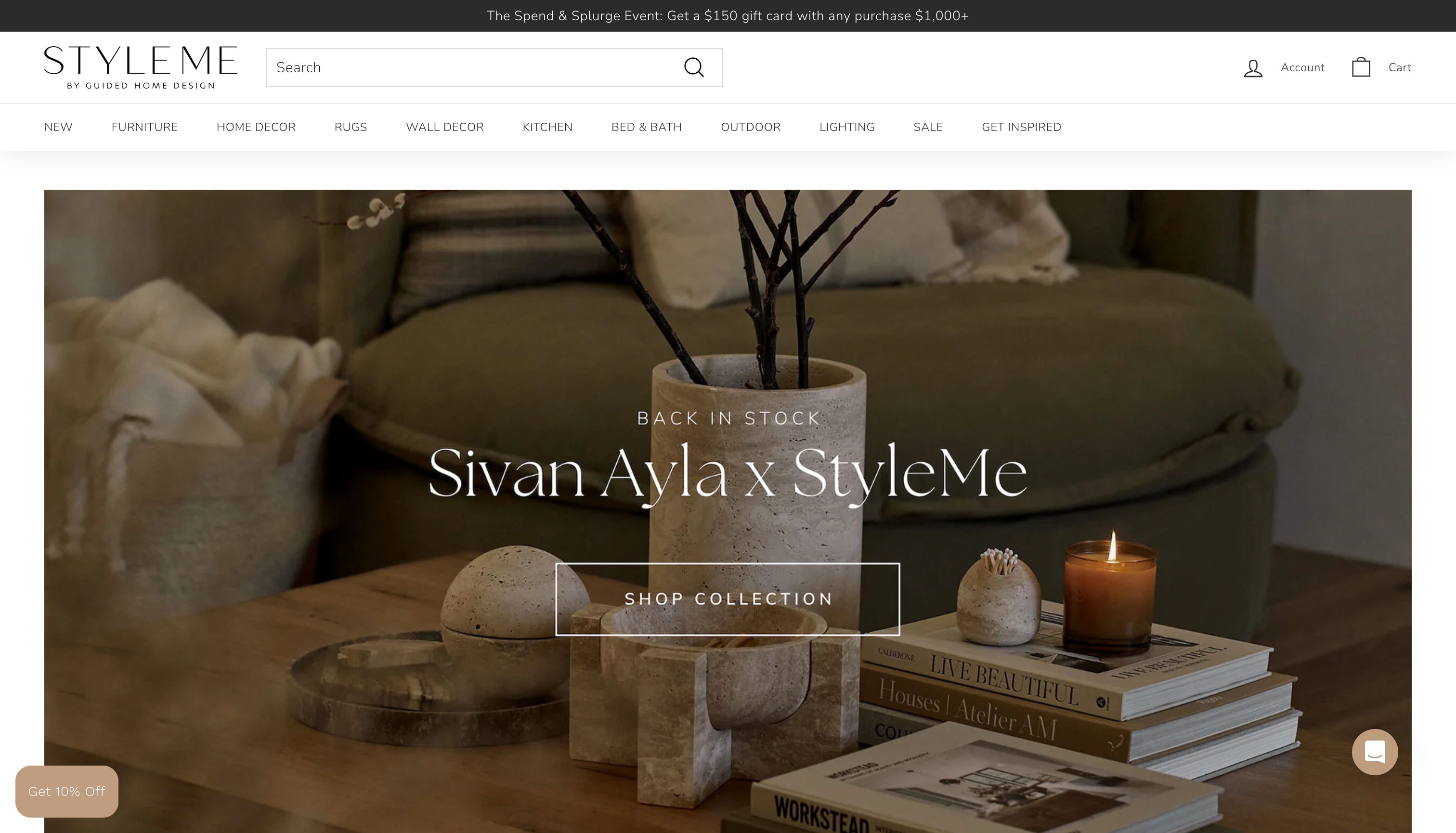
By using MESA, they were able to save time by automating the emails to customers with tracking links specific to their order which increased customer connections. Not only this, but they also improved customer retention. A simple step, but a great result.
Conclusion
Automated emails are a great way to increase customer engagement and drive more sales for your business. Following the strategies we discussed, such as segmenting your email list, personalizing content, and utilizing advanced email automation tactics can help you reach customers in meaningful ways.
Ultimately, by providing a better customer experience through automated emails, you’ll be able to improve loyalty and increase revenue for your business. With the right strategies in place, email automation is a powerful tool for any digital marketing strategy.
Additional Resources
If you’d like to further improve your email automation game, here is a list of helpful resources from the MESA blog to help you along:
How to scale your email marketing automation efforts
If you’d like to take full advantage of email marketing automation software, try MESA, a leader in Shopify automation and custom workflow solutions.
MESA offers a comprehensive suite of automation templates to help you create custom experiences for your business. You can easily set up automated emails, segment your list, keep all your customer’s data connected, and more.
Try MESA today and take your email automation to the next level.


